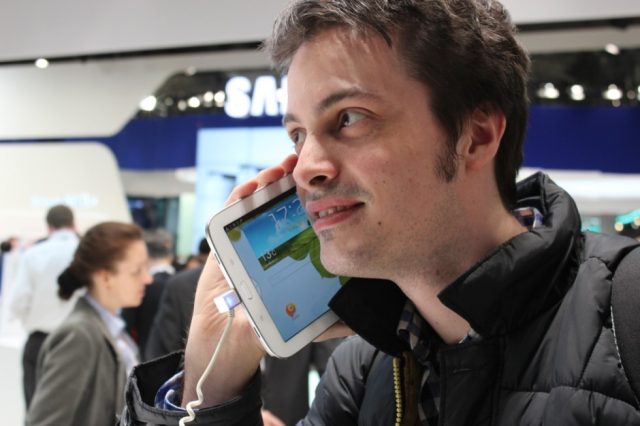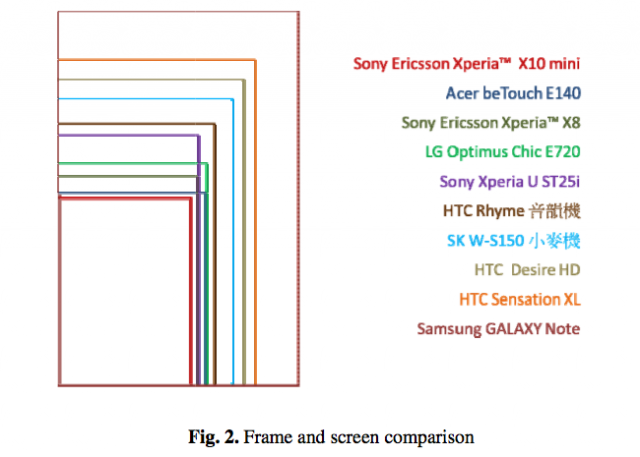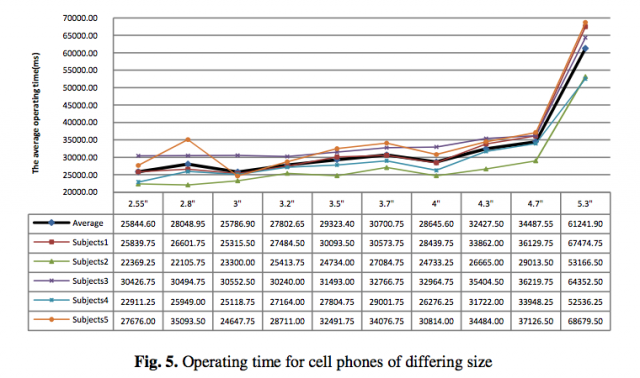
You don’t have to look too hard at the slate of new smartphones to see Android’s “bigger is better” ethos. While iPhones have remained resolutely conservatively sized, Android manufacturers continue to push the limits with phones like the 5.5-inch LG Optimus G Pro or the 6.3-inch Samsung Galaxy Mega.
Consumer choice is all well and good, but looking further at the range of available phones, it’s actually impossible to get any of the latest models and also get a phone that’s smaller than 4.7 inches. They just don’t exist anymore.
Of the recent releases on Verizon, AT&T, and Sprint (phones that cost at least $150, like the Samsung Galaxy S 4 or HTC One), all have 4.7-inch screens or larger. The two premium phones on T-Mobile are 5 inches and larger.
If you do want a smaller phone, you have to drop down to lower-priced phones in lesser quality brackets. On Verizon, there’s the old 4-inch Motorola Droid 4 for $100 or the 3.6-inch Casio G’zOne Commando for $50. On AT&T, there’s the 4-inch Samsung Galaxy Rugby Pro for $100. Sprint offers the 4-inch Kyocera Torque for $100, the 3.1-inch Motorola Admiral for $70, or the 3.5-inch ZTE Fury for free on contract.
The divide is pretty clear among Android phones: new models have large, shiny, nearly 5-inch screens; it’s only old or inexpensive phones that still have smaller screens.
There are some newer phones that do have sub-5-inch screens, fitting the “mini” trend. But these phones also have diminished internals. If you want the latest and best inside, a large outside is unavoidable.
Why size matters
To begin with, the “right” phone size for a user has almost as much to do with personal preference as comfort. There are trade-offs to both options: a screen 5 inches or larger is better for browsing and can display more content at once, but a screen smaller than 4.7 inches, and especially smaller than 4.3 inches, is easier to operate with one hand. The smaller your hands are, the more you’d be affected by the comfort trade-off in a one-handed scenario.
A very small-scale study presented at the end of July at the 15th Human Interface and the Management of Information conference in Las Vegas showed that screen size also has a practical implication: operating time. The study examined five people using 10 different phones with screen sizes ranging from 2.55 inches (Sony Xperia 10 mini) to 5.3 inches (a Galaxy Note). A basic app required participants to touch various parts of the screen in different patterns.


The experiment found that there is a jump in the time it takes to complete tasks when the screen increases in size from 4.3 to 4.7 inches, between a third and half a second. The operating time for the simple tasks nearly doubled in the jump from 4.3 to 5.3 inches, from between 3 and 3.5 seconds to between 6 and 6.5 seconds.
Hence, two advantages arise in favor of the smaller screen: operating time and holding comfort (though the two are related). And yet Android manufacturers are catering less and less to those advantages on the high-end of smartphones in favor of more size.
Certainly for people with bigger hands, a larger phone may decrease operating time (due to fewer mistakes) and may be more comfortable. But the handful of testers in the study above all had hands falling around the average hand length for males (18.9 cm) or larger, meaning that even for males with average or slightly above average hands, phones bigger than 4.5 inches are more of a pain to use than smaller ones. On a personal note, I have large hands for a woman (17.8 cm, to the 17.2 cm average), and I find 4-plus-inch phones to be too big in terms of one-handed operation.

Where have all the small phones gone?
Granted, this is only an inch we’re talking about, an inch that is a first world problem in the extreme. But given how central smartphones are to our lives now, it’s a pretty integral difference. It’s like if we wore pants that are 25 percent too long, or ate 25 percent more food than we wanted at every meal, or paid 25 percent more every time we bought something. It’s not much, but the frequency of interaction is enough that the effects add up.
Android handset manufacturers can’t actually be focused in a practical way on capturing the very-large-handed dude demographic. We know larger phones are marginally easier to read on, but why are there no high-end phones for those of us who have normal appendages and would rather have the operational tradeoff? Maybe the fact that women, who fill out more of the small-hands demographic, stereotypically don’t know or care about having powerful phones.
Manufacturers could possibly make the case that customers want to see more, bigger content on their phones, which is a valid argument. But a smartphone isn’t the passive, basic-interaction device that, say, an e-reader is. We are texting, we are e-mailing, we are searching, we are playing games, we are picking, pinching, and dragging. This is hard when I can't reach with my thumb that button in the screen’s corner over there, a long and empty stretch of pixels away.
The Android platform used to beat the drum of consumer choice loud and often, but only a few short years after the platform’s launch, phones have settled along a line in a two-dimensional spectrum: huge, expensive, and unwieldy, or small, inexpensive, and mediocre.
reader comments
286